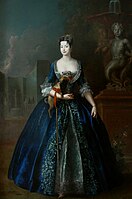Anna Karolina Orzelska

Anna Karolina Countess Orzelska (born November 23, 1707 in Warsaw , † September 27, 1769 in Grenoble ) was an illegitimate daughter of Augustus the Strong and, by marriage, Princess of Schleswig-Holstein-Sonderburg-Beck.
Life
Anna Karolina was the illegitimate daughter of the Elector and Polish King August II from his connection with the French Henriette Rénard-Duval , daughter of a wine merchant from Lyon . Shortly before she was born, her mother married the Parisian businessman François Drian. Anna Karolina therefore grew up in France.
In 1723, Friedrich August Rutowski , her half-brother, tracked her down in Paris and brought Anna Karolina, who was only 16 years old, to the Dresden court, where he first taught her fencing and allegedly presented her to his father in uniform (there is also a portrait of her in uniform of Silvestre). The king was delighted with her beauty and intelligence. On September 19, 1724 she found official and legal recognition and was awarded the title of Polish Countess Orzelska and was granted the right to live in the Blue Palace in Warsaw . As the leader of the exclusive circle around the king, she managed to gain great advantages for her family, which, however, earned her the opposition and envy of the old court nobility, who viewed her as an upstart.
It was rumored through Wilhelmine of Prussia that Countess Orzelska was not only the mistress , but also the bed-mate of her biological father and her half-brother, Count Rutowski. The extent to which incestuous circumstances actually existed or whether it was disapproving court gossip is not clear. Contemporary sources show, however, that Orzelska is said to have led a sexually dissolute lifestyle at court and liked to wear men's clothing, such as riding and soldiers' uniforms.
In February 1728 she was presented naked to the Prussian Crown Prince and later King Friedrich , who was visiting Dresden with his father, King Friedrich Wilhelm I. Although his father immediately prevented such an intimate meeting, a secret love affair that was widely received and which was continued during a return visit by August (with his daughter in the wake) in the same year in Berlin, but then became impossible. German historians of the 19th century, and in some cases later, saw in her not only Friedrich's first, but also formative or even only great love.
Louis de Silvestre : Anna Orzelska in Uniform , 1725
Antoine Pesne : Countess Orzelska, oil on canvas, around 1730
Rosalba Carriera : Countess Orzelska, oil on canvas, around 1730
On August 10, 1730, her father married her in Dresden to Karl Ludwig Friedrich, Prince of Schleswig-Holstein-Sonderburg-Beck (1690–1774), the younger brother of the ruling Duke Friedrich Wilhelm II. Her dowry was 300,000 thalers . A son, Karl Friedrich (1732–1772), emerged from the joint connection . After three years of marriage, her father and patron died. This was the reason for her husband to separate from her and move from Dresden to Königsberg . In the following decades she lived in much more modest circumstances in Rome , Venice and Avignon . Shortly before the end of her life, she went to Grenoble for a cure , where she died on September 27, 1769.
Web links
- Anna Caroline Orzelsk, Countess Orzelsk on thepeerage.com , accessed September 18, 2016.
Individual evidence
- ^ A b c Hermann Brockhaus (Ed.): General Encyclopedia of Sciences and Arts. Leipzig 1860, Volume 70: Glimes – Gnandstein. P. 326, column 1. ( books.google.de ).
- ↑ Johannes Scherr: The history of the German women. Leipzig 1860, Volume III, p. 408, note 156. ( books.google.de ).
- ↑ a b Tom Goeller: The old Fritz - man, monarch, myth . Hoffmann and Campe, 2011. ISBN 978-3-455-50219-0 digitized
- ^ Robert Schultheß: Friedrich and Voltaire in their personal and literary interrelationships. Nordhausen 1860. p. 2 f. ( [1] ).
| personal data | |
|---|---|
| SURNAME | Orzelska, Anna Karolina |
| ALTERNATIVE NAMES | Orzelska, Anna Karolina Countess; Anna Karolina of Schleswig-Holstein-Sonderburg-Beck |
| BRIEF DESCRIPTION | illegitimate daughter of Augustus the Strong, by marriage Princess of Schleswig-Holstein-Sonderburg-Beck |
| DATE OF BIRTH | November 23, 1707 |
| PLACE OF BIRTH | Warsaw |
| DATE OF DEATH | September 27, 1769 |
| Place of death | Grenoble |


